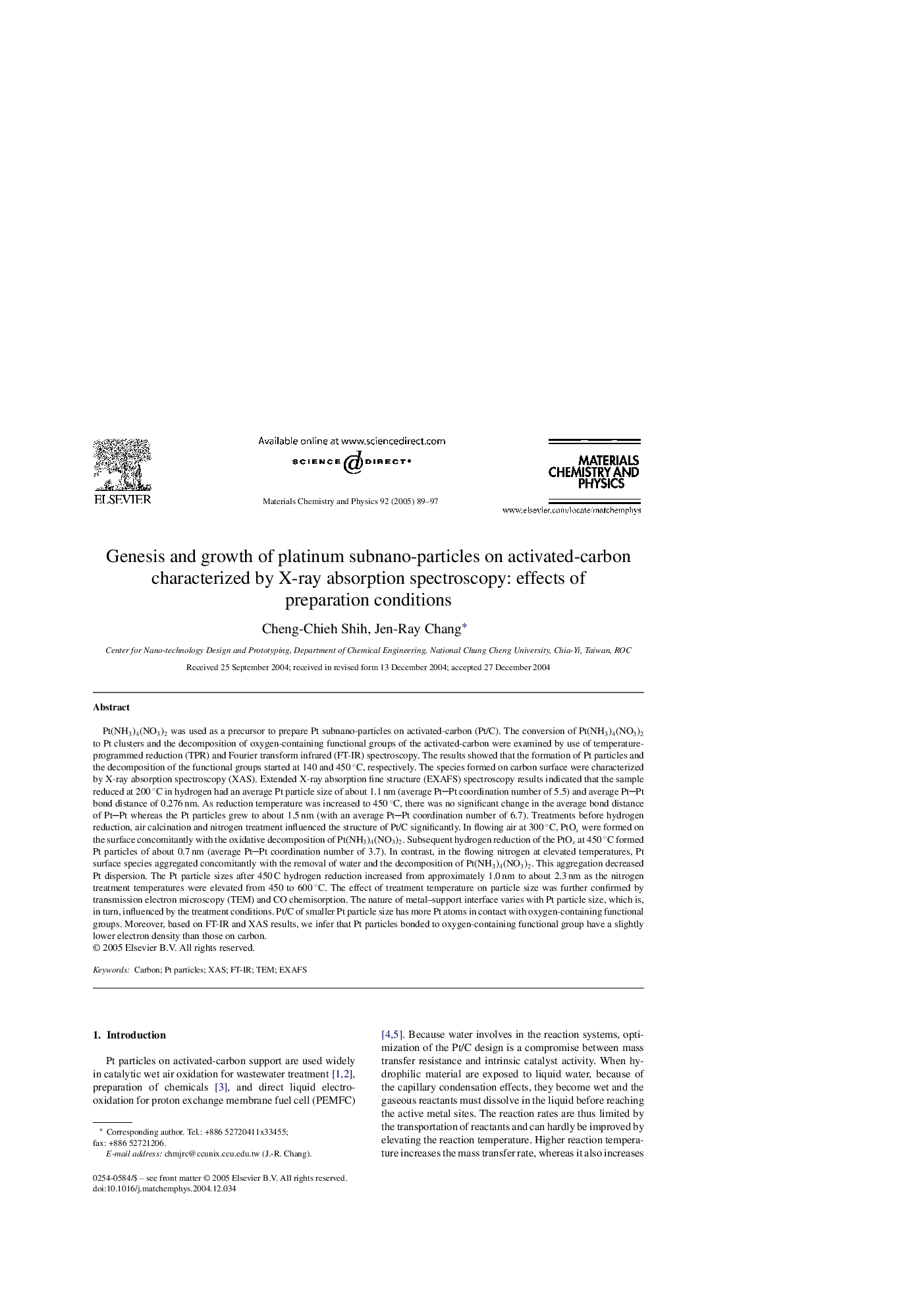| کد مقاله | کد نشریه | سال انتشار | مقاله انگلیسی | نسخه تمام متن |
|---|---|---|---|---|
| 10638214 | 995413 | 2005 | 9 صفحه PDF | دانلود رایگان |
عنوان انگلیسی مقاله ISI
Genesis and growth of platinum subnano-particles on activated-carbon characterized by X-ray absorption spectroscopy: effects of preparation conditions
دانلود مقاله + سفارش ترجمه
دانلود مقاله ISI انگلیسی
رایگان برای ایرانیان
کلمات کلیدی
موضوعات مرتبط
مهندسی و علوم پایه
مهندسی مواد
مواد الکترونیکی، نوری و مغناطیسی
پیش نمایش صفحه اول مقاله

چکیده انگلیسی
Pt(NH3)4(NO3)2 was used as a precursor to prepare Pt subnano-particles on activated-carbon (Pt/C). The conversion of Pt(NH3)4(NO3)2 to Pt clusters and the decomposition of oxygen-containing functional groups of the activated-carbon were examined by use of temperature-programmed reduction (TPR) and Fourier transform infrared (FT-IR) spectroscopy. The results showed that the formation of Pt particles and the decomposition of the functional groups started at 140 and 450 °C, respectively. The species formed on carbon surface were characterized by X-ray absorption spectroscopy (XAS). Extended X-ray absorption fine structure (EXAFS) spectroscopy results indicated that the sample reduced at 200 °C in hydrogen had an average Pt particle size of about 1.1 nm (average PtPt coordination number of 5.5) and average PtPt bond distance of 0.276 nm. As reduction temperature was increased to 450 °C, there was no significant change in the average bond distance of PtPt whereas the Pt particles grew to about 1.5 nm (with an average PtPt coordination number of 6.7). Treatments before hydrogen reduction, air calcination and nitrogen treatment influenced the structure of Pt/C significantly. In flowing air at 300 °C, PtOx were formed on the surface concomitantly with the oxidative decomposition of Pt(NH3)4(NO3)2. Subsequent hydrogen reduction of the PtOx at 450 °C formed Pt particles of about 0.7 nm (average PtPt coordination number of 3.7). In contrast, in the flowing nitrogen at elevated temperatures, Pt surface species aggregated concomitantly with the removal of water and the decomposition of Pt(NH3)4(NO3)2. This aggregation decreased Pt dispersion. The Pt particle sizes after 450 C hydrogen reduction increased from approximately 1.0 nm to about 2.3 nm as the nitrogen treatment temperatures were elevated from 450 to 600 °C. The effect of treatment temperature on particle size was further confirmed by transmission electron microscopy (TEM) and CO chemisorption. The nature of metal-support interface varies with Pt particle size, which is, in turn, influenced by the treatment conditions. Pt/C of smaller Pt particle size has more Pt atoms in contact with oxygen-containing functional groups. Moreover, based on FT-IR and XAS results, we infer that Pt particles bonded to oxygen-containing functional group have a slightly lower electron density than those on carbon.
ناشر
Database: Elsevier - ScienceDirect (ساینس دایرکت)
Journal: Materials Chemistry and Physics - Volume 92, Issue 1, 15 July 2005, Pages 89-97
Journal: Materials Chemistry and Physics - Volume 92, Issue 1, 15 July 2005, Pages 89-97
نویسندگان
Cheng-Chieh Shih, Jen-Ray Chang,